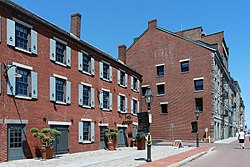Long Wharf (Boston)
|
Long Wharf and Customhouse Block
|
|
 |
|
| Location | Boston, Massachusetts |
|---|---|
| Coordinates | 42°21′37″N 71°2′59″W / 42.36028°N 71.04972°WCoordinates: 42°21′37″N 71°2′59″W / 42.36028°N 71.04972°W |
| Area | 3 acres (1.2 ha) |
| Built | 1710 |
| NRHP Reference # | 66000768 |
| Significant dates | |
| Added to NRHP | November 13, 1966 |
| Designated NHL | November 13, 1966 |
Long Wharf (built 1710-1721) is a historic pier in Boston, Massachusetts which once extended from State Street nearly a half-mile into Boston Harbor. Today, the much-shortened wharf (due to landfill on the city end) functions as a dock for passenger ferries and sightseeing boats.
Construction of the wharf began around 1710. As originally built the wharf extended from the shoreline adjacent to Faneuil Hall and was one-third of a mile long, thrusting considerably farther than other wharves into deep water and thus allowing larger ships to tie up and unload directly to new warehouses and stores. "Constructed by Captain Oliver Noyes, it was lined with warehouses and served as the focus of Boston's great harbor." Over time the water areas surrounding the landward end of the wharf were reclaimed, including the areas now occupied by Quincy Market and the Customs House.
"At the wharf's head in the 18th century was the Bunch-of-Grapes Tavern. The painter John Singleton Copley spent his childhood on the wharf, where his mother had a tobacco shop." The 1760s Gardiner Building, once home to John Hancock's counting house and now a restaurant, is the wharf's oldest surviving structure.
Among several similar structures, a grand granite warehouse known as the Custom House Block was built in 1848 atop the wharf; it has survived into the 21st century. The mid-19th century was the height of Boston's importance as a shipping center, lasting roughly until the American Civil War. Long Wharf was the central focus of much of this economic activity.
In the late 1860s, as the city's port began to decline in importance as an international shipping destination,Atlantic Avenue was cut through this and other wharves, changing the face of the waterfront.
The construction of the elevated Central Artery along Atlantic Avenue in the 1950s separated Long Wharf from Boston's business district.
...
Wikipedia
